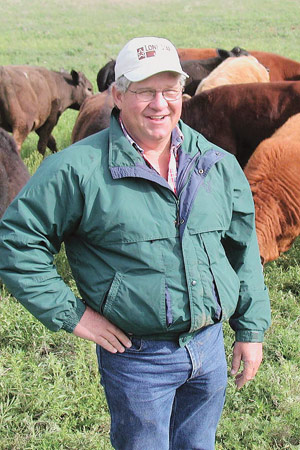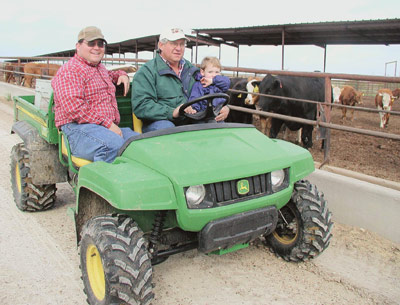
Photos by Nancy Jorgensen
You may have noticed that the price of beef at the grocery store is down this year. That’s good news if you’re buying steak, but it’s not so good for cattle producers like Larry Stewart and his son, Kirk.
“Beef prices are down about 20 percent,” says Larry, a lifelong cattleman, who ranches southwest of Forth Worth, Texas. “If the economy picks up, we’ll start doing better. Demand for beef goes up when people have more to spend.”
Fortunately for the Stewarts, their staying power in the cattle business does not depend entirely on beef prices. Nearby Weatherford, Texas, calls itself the cutting horse capital of the world, and the Stewarts have built a solid reputation as a source of calves for cutting horse competitors.
“The cutting industry has driven our business for 10 years,” Larry says. “Cutting has grown unbelievably. We can’t furnish all the cattle they need.”
Leasing Heifers to Horse Trainers
The Stewarts, who are Lone Star Ag Credit customers, lease 300 to 400 calves at a time for 30-day stretches to horse trainers. The trainers prefer to work with heifers over steers, because heifers are more active. Larry and Kirk also lease approximately 1,000 heifers for cutting shows several days each month, except July and August. In competition, the cutting horse and rider must work together as a team to separate a single calf from the herd and keep it from returning to the herd, controlling it with lightning fast starts and turns.
“At the shows, they want fresh cattle, and so each animal is only used one time for cutting events,” Larry explains.
The lease payments bump up the Stewarts’ profitability, provide insurance against the cattle market in lean years and are the “icing on the cake” for them in good years. Still, their bread and butter is raising stocker cattle and feeding them under retained ownership.
This year, they have more than 3,000 calves in their own feedyard and another 1,500 head on pasture.
In the past, the Stewarts bought their stock at sale barns, but they can no longer find enough local cattle that meet their requirements. Now they work with brokers to buy newly weaned five-month-old calves, trucking them in from south Texas, Alabama and Florida.
The calves generally weigh between 400 and 500 pounds when they arrive at the Stewarts’ ranch. Over the next month to month and a half, they are carefully fed and nurtured by Larry and Kirk, who pride themselves on calf care.
Focus on Health
“It’s a critical time,” Larry says. “They’re away from their mother’s milk, and they have to learn to eat feed. Plus they’ve been exposed to diseases at sale barns.”
At the Stewart ranch, new calves are vaccinated, doctored and tagged, and calves that are going to stay awhile are branded with the family’s Bar L brand — short for Larry or “lucky,” the owner jokes.
“We try to get them healthy over 30 to 45 days, put about 100 to 150 pounds on them and then send them on to feedlots closer to where feed is grown,” Larry explains. At approximately 550 to 650 pounds, the calves are trucked to the Stewarts’ partner in Sublette, Kan., for finishing.
“We don’t raise bulls, we don’t have mamas; we just buy and sell calves,” Larry explains. “Mamas take so much grass, and land is so high-priced here that we have limited acreage.”
“The cutting industry has driven our business for 10 years… We can’t furnish all the cattle they need.” - Larry Stewart
While six generations of the family have called the area home, Larry purchased his current ranch, situated on rolling hills near Granbury — less than an hour’s drive from downtown Fort Worth — 12 years ago.
Jason Pettit, vice president of Lone Star Ag Credit, attributes Larry’s success to his “conservative nature, uncanny knowledge of cattle and business savvy” — savvy that includes a shrewd ability to select cattle that offer strong profit potential.
“We can’t always buy the best,” Larry says. “It costs too much. We buy a medium-grade animal and upgrade it.” They buy all breeds except dairy and longhorn cattle.
Don’t Buy More Than You Can Feed
“One thing I’ve learned: Don’t buy more calves than you can take care of,” Larry says. “It would be hard to take care of this many calves without Kirk.” For 10 years, Kirk has fed cattle full time with his dad, commuting to the ranch from nearby Acton.
Larry offers another piece of business advice: “Never borrow more than you can pay back. A lot of people keep as little as $100 a head in equity. I’m more conservative,” he says. In fact, he maintains equity of at least $300 of each animal’s value.
This conservative business philosophy also has guided Larry in his 25 years of representing fellow farmers and ranchers on the Lone Star Ag Credit Board of Directors, as well as on the board of First National Bank – Granbury.

From left, Kirk, Larry and Samuel Stewart. A couple of days a week, Samuel comes out to the ranch with Kirk to help check cattle.
“Farm Credit has always been good to me,” Larry says. “They know agriculture, so they’re not scared off by the ups and downs in our business. Their people have technology that other banks don’t, and they care about their customers. Still, the recent credit crisis keeps all lenders looking more closely at equity requirements.”
Like Father, Like Son
Farm Credit connections run deep in the Stewart family. Larry’s father was involved with a former Farm Credit cooperative, Stephenville Production Credit Association, and now Kirk is carrying on the Farm Credit tradition. Previously, Kirk obtained his operating funds from a feedlot company, but he now borrows from Lone Star Ag Credit, which requires more accountability. “It makes me more aware of how I’m doing,” he says.
According to Pettit, who services the ranch’s operating loans, Kirk has what it takes to succeed in the cattle industry. “With his dad’s guidance, Kirk was running 1,000 head of feedlot cattle before he was 25. Like his father, Kirk excels in his financial relationships as well as his business,” Pettit says.
Last year, Lone Star Ag Credit tapped Kirk to serve on the lender’s new advisory board, whose mission is to help young, beginning and small operators. “My idea was to get Lone Star’s message into high school ag classes,” Kirk says. “I think it does more good to educate young kids than someone who’s fresh out of college.”
According to Kimberly Thomas, senior vice president of marketing for Lone Star, “Kirk’s knowledge of the industry is immense. We’re implementing his ideas.”
Larry identifies another trait that serves Kirk well: “Nothing worries him. A bomb could go off, and he would remain calm. You can’t panic in this business, or you’d be shell-shocked all the time.”
When Larry dreams of the future, it’s not about raising more cattle, however; it’s about spending more time with family. His wife, Suzy, is a small animal veterinarian. Kirk and Kirk’s wife, Jodi, are the proud parents of Samuel and newborn Eli. Another son, Keith, a firefighter, and Keith’s wife, Christy, live nearby. Keith helps at the ranch on his days off. Daughter Mallory Meyers attends Texas A&M University.
“My best days are when my sons are here, and Samuel comes out, and I get to play with them,” says Larry, a former snow skier and scuba diver. “I hope Samuel and Eli will prompt me to take more trips, but it ain’t bad right here.”
– Nancy Jorgensen